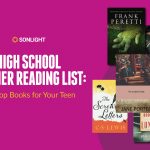Reading Lists Can Last a Lifetime
Homeschooled children will eventually grow up and reflect on their school years through the lens of adulthood. What will your children say about their homeschool experience? My two children are now grown adults, but they have warm memories about our years learning together. I recently asked them what they remembered from a dozen years ago. Their answers didn't involve lesson plans, tests, textbooks, or chores. They remembered the time spent reading aloud great books together on the couch.
I am convinced that the greatest advantage of homeschooling is the time spent together. I encourage parents to homeschool through high school, and read quality literature aloud together until children graduate. Reading aloud can create lifelong warmth in your parent-child relationship. This "cozy couch time" is irreplaceable, and creates positive memories of childhood and homeschooling that can last forever. At home, you can substitute meaningful dialog for literary analysis, and develop a deep love of reading.
Reading aloud is a technology-free, relaxed way to learn and enjoy books. Like camping, reading together creates shared experiences that can help with family bonding. But extensive reading is not just for personal enjoyment and academic edification, it can also help you create excellent high school records and increase your child's chances of college admission and scholarships.
Reading Lists: A Key Element in Your Homeschool Portfolio
One of your tasks as a homeschool parent is not only to give your kids a good education, but to demonstrate the breadth and depth of their education to the people who need "proof" of their learning. Keeping a record of what your students have read will help you to show the quality and variety of literature they've experienced. Compiling your students' reading lists during high school means you will have this to share as part of a college portfolio (along with a transcript, extracurricular activities, writing samples, etc.).
How to Build Your Reading List
A reading list is simply an alphabetical list of book that a high school child has read. The list is simple, title and author only, not a bibliography. The book can be reading for fun, literature reading for school, and historical reading for school. Whether the list is 8 books or 800, the reading list is just for books read during high school years.
A reading list should include books read for school, whether for history or literature class. It should also include books read for fun, such as light books assigned for reading, or twaddle teens choose on their own. You don't have to specify which books were read aloud, and which were read independently. My children's reading lists included simply title and author, because that is all that most colleges expect.
Save receipts from bookstore purchases, and library records, as well as your curriculum book list, to add to your child's list. My prolific readers added books from chess study, economics, history, and Russian authors. I felt guilty that I couldn't keep their reading lists current, but they read so much it was impossible! I alphabetized each reading list, to make sure I didn't include any duplicate titles, and figured enough was enough. Colleges don't need to know about every single book that a geeky, bookish kid has read.
While it may be normal for a public school student to read 5-10 books per year, some homeschoolers read too many to count. Once you get past 30-50 books on your child's yearly list, stop worrying about it. You have demonstrated that your child is a prolific reader, well-read across the curriculum.
Course Descriptions
You can include books from your reading list in your child's course descriptions, demonstrating the quality of your homeschool. Normally a course description includes what the class covered, the text used, and a demonstration of how you graded it. If 1/3 of the total grade is based on reading, then your list of books in the course description will clearly demonstrate the amount of work involved. When you use a literature-based curriculum (I used Sonlight), then it makes sense to divide their extensive book list into subjects. Some books can be reserved for the history course description, and some for the English course description, but include all of them on the book list.
My course descriptions can look intimidating to people outside my family, because they include the fun books my kids wanted to read independently. My kids read so many books simply for fun. When they read a library book or received a book for their birthday, I included it in the course description for the class that covered the topic. When my son read the books, "Rich Dad Poor Dad" and "Biblical Economics in Comics" we added them to his self-directed Economics course description.
Transcript
Your child's reading list may help you create the best descriptive titles for your high school classes. Look over the books for clues that will help you with course titles. Do you have a smattering of different genre and a variety of writing assignments? You may want to name your English class, "Literature and Composition." Is your child's reading list heavily focused on American authors? You may want to name your English class, "American Literature and Composition."
While I didn't use a specific "American Literature" curriculum, my children read literature by American authors extensively one year. I noticed we had combined the poetry of Walt Whitman, Robert Service, and Langston Hughes with the novels of Mark Twain, Jack London, and Nathaniel Hawthorne. Confident that we had covered many major works, I named the class, "American Literature and Composition" on the homeschool transcript.
Scholarships
Colleges want applicants who are well educated, and demonstrate wide-ranging experiences through literature. They want children who can read challenging literature from a College Bound Reading List. But colleges also want unique individuals with their own personal preferences and a passion for their own interests. As you include reading for fun in your child's course descriptions, you are making your child's homeschool records unique.
Each of my children received full-tuition scholarships to their first choice university. One college representative said, "Your transcripts and records were the best organized and documented I have seen." This didn't happen because my children were the best organized, or because I forced them to read excessive amounts of literature beyond the curriculum requirements. It happened because I took their normal, natural homeschool experiences, and translated their delight directed learning into words and numbers colleges understand: transcripts, course descriptions, and reading lists.
Life-Long Benefits
Reading strengthens relationships, shapes personalities, develops critical thinking, and builds connections between ideas. It builds character as children identify with heroes, and helps them learn from the mistakes of others as they live vicariously through the characters. It provides broad exposure to cultures and ideas, allowing children to dig deeply into subjects from the safety of home with the guidance of their parents.
All these benefits are much more secure than any derived from the world wide web, with the dark side of humanity just one click away. And since reading is analog, not digital, it promotes a normal attention span, without the quickly moving change of focus offered by all forms of digital media. The slower pace of reading promotes reflection and increases imagination. Reading aloud can turn an otherwise boring or ordinary homeschool experience into fond memories cherished for a lifetime.
All these benefits pale in comparison to the benefit near and dear to my heart. My children love reading, even now as adults. They laugh and comment about books we read together a decade ago. They are thankful we homeschooled and remember the bond we developed during read aloud time, not the struggles or stress. All that remains are the life-long benefits of homeschooling. I'm so thankful for our reading time together through my entire homeschool career.
~~~~~~~~~~~~~~~~~~~~~~~~~~~~~~~~~~~~~~~~~~~~~~~~~~~~~~~~~~~~
GIVEAWAY TIME!! Today, one reader will win a copy of Lee's new devotional book Finding the Faith to Homeschool High School. This weekly devotional covers the challenges parents face while homeschooling high school and can support and encourage you along the way. Tell us in the comments why you think homeschooling for high school might be worth it, or what your biggest challenge is. I'll pick one winner from the blog and Facebook comments to win a copy of Lee's book! ~Laura
 Lee Binz, The HomeScholar is a dynamic homeschool speaker and author of several books such as Setting the Records Straight: How to Craft Homeschool Transcripts and Course Descriptions for College Admission and Scholarships. Lee’s mission is to encourage and equip parents to homeschool through high school. For a daily dose of high school help, check out the Freebies tab at www.TheHomeScholar.com, including her free mini-course, "How to Avoid the 5 Biggest Mistakes Parents Make Homeschooling High School."
Lee Binz, The HomeScholar is a dynamic homeschool speaker and author of several books such as Setting the Records Straight: How to Craft Homeschool Transcripts and Course Descriptions for College Admission and Scholarships. Lee’s mission is to encourage and equip parents to homeschool through high school. For a daily dose of high school help, check out the Freebies tab at www.TheHomeScholar.com, including her free mini-course, "How to Avoid the 5 Biggest Mistakes Parents Make Homeschooling High School."









3 Comments